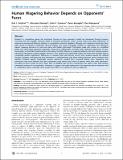Human Wagering Behavior Depends on Opponents' Faces
Author(s)
Schlicht, Erik J.; Shimojo, Shinsuke; Camerer, Colin F.; Nakayama, Ken; Battaglia, Peter W.
DownloadSchlicht-2010-Human Wagering Behav.pdf (688.3Kb)
PUBLISHER_CC
Publisher with Creative Commons License
Creative Commons Attribution
Terms of use
Metadata
Show full item recordAbstract
Research in competitive games has exclusively focused on how opponent models are developed through previous outcomes and how peoples' decisions relate to normative predictions. Little is known about how rapid impressions of opponents operate and influence behavior in competitive economic situations, although such subjective impressions have been shown to influence cooperative decision-making. This study investigates whether an opponent's face influences players' wagering decisions in a zero-sum game with hidden information. Participants made risky choices in a simplified poker task while being presented opponents whose faces differentially correlated with subjective impressions of trust. Surprisingly, we find that threatening face information has little influence on wagering behavior, but faces relaying positive emotional characteristics impact peoples' decisions. Thus, people took significantly longer and made more mistakes against emotionally positive opponents. Differences in reaction times and percent correct were greatest around the optimal decision boundary, indicating that face information is predominantly used when making decisions during medium-value gambles. Mistakes against emotionally positive opponents resulted from increased folding rates, suggesting that participants may have believed that these opponents were betting with hands of greater value than other opponents. According to these results, the best “poker face” for bluffing may not be a neutral face, but rather a face that contains emotional correlates of trustworthiness. Moreover, it suggests that rapid impressions of an opponent play an important role in competitive games, especially when people have little or no experience with an opponent.
Date issued
2010-07Department
Massachusetts Institute of Technology. Department of Brain and Cognitive SciencesJournal
PLoS ONE
Publisher
Public Library of Science
Citation
Schlicht, Erik J. et al. “Human Wagering Behavior Depends on Opponents' Faces.” PLoS ONE 5.7 (2010): e11663.
Version: Final published version
ISSN
1932-6203